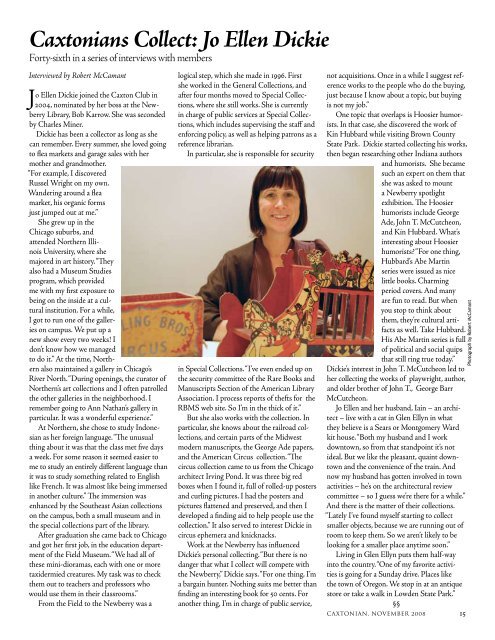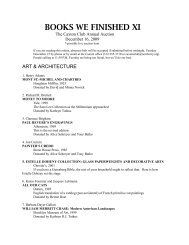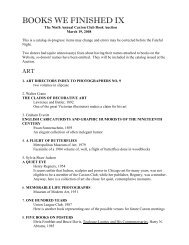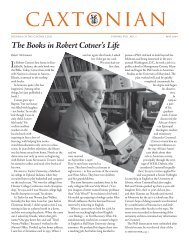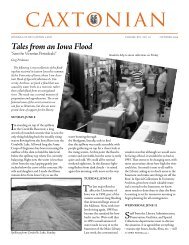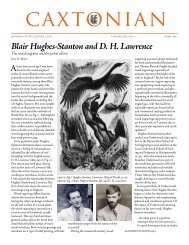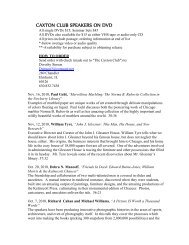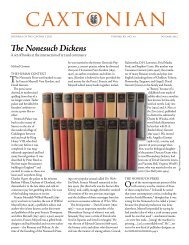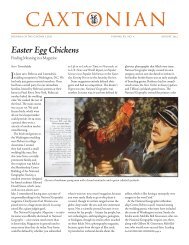Collecting Pushkin - The Caxton Club
Collecting Pushkin - The Caxton Club
Collecting Pushkin - The Caxton Club
You also want an ePaper? Increase the reach of your titles
YUMPU automatically turns print PDFs into web optimized ePapers that Google loves.
<strong>Caxton</strong>ians Collect: Jo Ellen Dickie<br />
Forty-sixth in a series of interviews with members<br />
Interviewed by Robert McCamant<br />
Jo Ellen Dickie joined the <strong>Caxton</strong> <strong>Club</strong> in<br />
2004, nominated by her boss at the Newberry<br />
Library, Bob Karrow. She was seconded<br />
by Charles Miner.<br />
Dickie has been a collector as long as she<br />
can remember. Every summer, she loved going<br />
to flea markets and garage sales with her<br />
mother and grandmother.<br />
“For example, I discovered<br />
Russel Wright on my own.<br />
Wandering around a flea<br />
market, his organic forms<br />
just jumped out at me.”<br />
She grew up in the<br />
Chicago suburbs, and<br />
attended Northern Illinois<br />
University, where she<br />
majored in art history. “<strong>The</strong>y<br />
also had a Museum Studies<br />
program, which provided<br />
me with my first exposure to<br />
being on the inside at a cultural<br />
institution. For a while,<br />
I got to run one of the galleries<br />
on campus. We put up a<br />
new show every two weeks! I<br />
don’t know how we managed<br />
to do it.” At the time, Northern<br />
also maintained a gallery in Chicago’s<br />
River North. “During openings, the curator of<br />
Northern’s art collections and I often patrolled<br />
the other galleries in the neighborhood. I<br />
remember going to Ann Nathan’s gallery in<br />
particular. It was a wonderful experience.”<br />
At Northern, she chose to study Indonesian<br />
as her foreign language. “<strong>The</strong> unusual<br />
thing about it was that the class met five days<br />
a week. For some reason it seemed easier to<br />
me to study an entirely different language than<br />
it was to study something related to English<br />
like French. It was almost like being immersed<br />
in another culture.” <strong>The</strong> immersion was<br />
enhanced by the Southeast Asian collections<br />
on the campus, both a small museum and in<br />
the special collections part of the library.<br />
After graduation she came back to Chicago<br />
and got her first job, in the education department<br />
of the Field Museum. “We had all of<br />
these mini-dioramas, each with one or more<br />
taxidermied creatures. My task was to check<br />
them out to teachers and professors who<br />
would use them in their classrooms.”<br />
From the Field to the Newberry was a<br />
logical step, which she made in 1996. First<br />
she worked in the General Collections, and<br />
after four months moved to Special Collections,<br />
where she still works. She is currently<br />
in charge of public services at Special Collections,<br />
which includes supervising the staff and<br />
enforcing policy, as well as helping patrons as a<br />
reference librarian.<br />
In particular, she is responsible for security<br />
in Special Collections. “I’ve even ended up on<br />
the security committee of the Rare Books and<br />
Manuscripts Section of the American Library<br />
Association. I process reports of thefts for the<br />
RBMS web site. So I’m in the thick of it.”<br />
But she also works with the collection. In<br />
particular, she knows about the railroad collections,<br />
and certain parts of the Midwest<br />
modern manuscripts, the George Ade papers,<br />
and the American Circus collection. “<strong>The</strong><br />
circus collection came to us from the Chicago<br />
architect Irving Pond. It was three big red<br />
boxes when I found it, full of rolled-up posters<br />
and curling pictures. I had the posters and<br />
pictures flattened and preserved, and then I<br />
developed a finding aid to help people use the<br />
collection.” It also served to interest Dickie in<br />
circus ephemera and knicknacks.<br />
Work at the Newberry has influenced<br />
Dickie’s personal collecting. “But there is no<br />
danger that what I collect will compete with<br />
the Newberry,” Dickie says. “For one thing, I’m<br />
a bargain hunter. Nothing suits me better than<br />
finding an interesting book for 50 cents. For<br />
another thing, I’m in charge of public service,<br />
not acquisitions. Once in a while I suggest reference<br />
works to the people who do the buying,<br />
just because I know about a topic, but buying<br />
is not my job.”<br />
One topic that overlaps is Hoosier humorists.<br />
In that case, she discovered the work of<br />
Kin Hubbard while visiting Brown County<br />
State Park. Dickie started collecting his works,<br />
then began researching other Indiana authors<br />
and humorists. She became<br />
such an expert on them that<br />
she was asked to mount<br />
a Newberry spotlight<br />
exhibition. <strong>The</strong> Hoosier<br />
humorists include George<br />
Ade, John T. McCutcheon,<br />
and Kin Hubbard. What’s<br />
interesting about Hoosier<br />
humorists? “For one thing,<br />
Hubbard’s Abe Martin<br />
series were issued as nice<br />
little books. Charming<br />
period covers. And many<br />
are fun to read. But when<br />
you stop to think about<br />
them, they’re cultural artifacts<br />
as well. Take Hubbard.<br />
His Abe Martin series is full<br />
of political and social quips<br />
that still ring true today.”<br />
Dickie’s interest in John T. McCutcheon led to<br />
her collecting the works of playwright, author,<br />
and older brother of John T., George Barr<br />
McCutcheon.<br />
Jo Ellen and her husband, Iain – an architect<br />
– live with a cat in Glen Ellyn in what<br />
they believe is a Sears or Montgomery Ward<br />
kit house. “Both my husband and I work<br />
downtown, so from that standpoint it’s not<br />
ideal. But we like the pleasant, quaint downtown<br />
and the convenience of the train. And<br />
now my husband has gotten involved in town<br />
activities – he’s on the architectural review<br />
committee – so I guess we’re there for a while.”<br />
And there is the matter of their collections.<br />
“Lately I’ve found myself starting to collect<br />
smaller objects, because we are running out of<br />
room to keep them. So we aren’t likely to be<br />
looking for a smaller place anytime soon.”<br />
Living in Glen Ellyn puts them half-way<br />
into the country. “One of my favorite activities<br />
is going for a Sunday drive. Places like<br />
the town of Oregon. We stop in at an antique<br />
store or take a walk in Lowden State Park.”<br />
§§<br />
CAXTONIAN, NOVEMBER 2008 15<br />
Photograph by Robert McCamant


